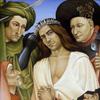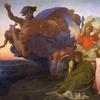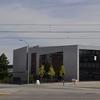Egon Schiele: Offensive or Avant-Garde?
- MUNICH, Germany
- /
- November 13, 2015
Immoral and depraved or just explicit and simply different? What earned the artist disrepute in the early 20th century makes him one of the greatest protagonists of Viennese Expressionism. Now Egon Schiele's masterpiece "Mädchen mit Federboa" will be offered in an auction of Modern Art / Post War / Contemporary Art at Ketterer Kunst in Munich, Germany from December 3-5, 2015.
The frontality and permissiveness of the nude from 1910, coupled with an unsparing aggressive coloring, neither matched contemporary taste and aesthetic principles nor prevailing morals. Accordingly, it was no surprise that this work was seen as a provocation. However, the year 1910 saw great progress in the development of Schiele's stylistic means, which found expression in an intensified coloring and the figures' positioning in front of an undefined blank background. Early that year Schiele contoured his models with strong lines of charcoal, while he made increasing use of the pencil later on; he also put less emphasis on a detailed illustration of the carnation than he used to, instead he preferred a more intensive treatment of face and hair. Additionally, the choice of young and impatient models forced the artist to a more spontaneous and liberal performance. Half way into the year, Schiele began to experiment with gouache colors, which, as it is the case in our work, he used to accentuate draperies and cloths. Accordingly, this nude, estimated at € 600,000-800,000, is a prime example of the artistic progress Egon Schiele made in this time.
Other highlights in the section of Modern Art come from Erich Heckel ("Hügellandschaft", estimate: € 450,000-550,000), Paula Modersohn-Becker ("Kinder vor Bauernhaus/Birkenstämme und Haus", estimate: € 300,000-400,000), Lyonel Feininger ("The Baltic (V-Cloud)", estimate: €250,000-350,000), Ernst Barlach ("Der Bettler", estimate: € 200,000-250,000), Emil Nolde („Das Meer (Bewegte blaue See mit mächtigen Wogen)", estimate: € 150,000-250,000), Karl Schmidt Rottluff (Stillleben mit Astern-Strauss, estimate: € 150.000-200.000) and Georg Schrimpf ("Stillende Mutter", estimate: € 140,000-180,000), as well as from Otto Dix, Conrad Felixmüller, Karl Hofer, Alexej von Jawlensky, Max Liebermann, Franz Marc, Otto Mueller and Pablo Picasso. A highlight of its own kind are more than 20 lot numbers from the œuvre of Gabriele Münter.
The section of Post War art offers several masterpieces with estimates in six digit realms by ZERO artists such as Günther Uecker, Otto Piene and Heinz Mack, as well as by Gerhard Richter ("Abstraktes Bild", estimate: € 400,000-600,000), Robert Longo ("Untitled (Starfield #2), estimate: € 250,000-350,000), Anselm Kiefer ("Maria im Rosenhag", estimate: € 250,000-350,000), Sean Scully ("Uist", estimate: € 200,000-300,000), Shozo Shimamoto (estimate: € 150,000-250,000), Gotthard Graubner ("Camelionid", estiamte: € 150,000-250,000) and Josef Albers ("Study for Homage to the Square", estimate: € 120,000-150,000). Further exciting works come from artists such as Agostino Bonalumi, Günther Förg, Rupprecht Geiger, Roy Lichtenstein, Marino Marini and Sigmar Polke.
Next to a work by Jonas Burgert that has been estimated with € 60,000-80,000, the section of Contemporary Art offers pieces by acclaimed artists such as Anselm Reyle (estimate: € 50,00060,000), Dan Colen ("Gum painting", estimate: € 50,000-70,000), Jason Martin ("Chaperon", estimate: € 40,000-60,000), Huan Zhang ("Earthlife No.16", estimate: € 30.000-40.000), Don Eddy ("Bumper Section VI: Berkeley, estimate: € 30,000-35,000) and David Schnell ("Pilze", estimate: € 28,000-32,000).










100x100_c.jpg)

![Offering a Truce [Bested], 1895, is estimated to sell for between $1,300,000 and $1,800,000 on March 22, 2014, for The Russell: An Exhibition and Sale to Benefit the C.M. Russell Museum. Offering a Truce [Bested], 1895, is estimated to sell for between $1,300,000 and $1,800,000 on March 22, 2014, for The Russell: An Exhibition and Sale to Benefit the C.M. Russell Museum.](/images/c/a8/20/Dec10_Offering_a_Truce__Bested_300dpi100x100_c.jpg)

